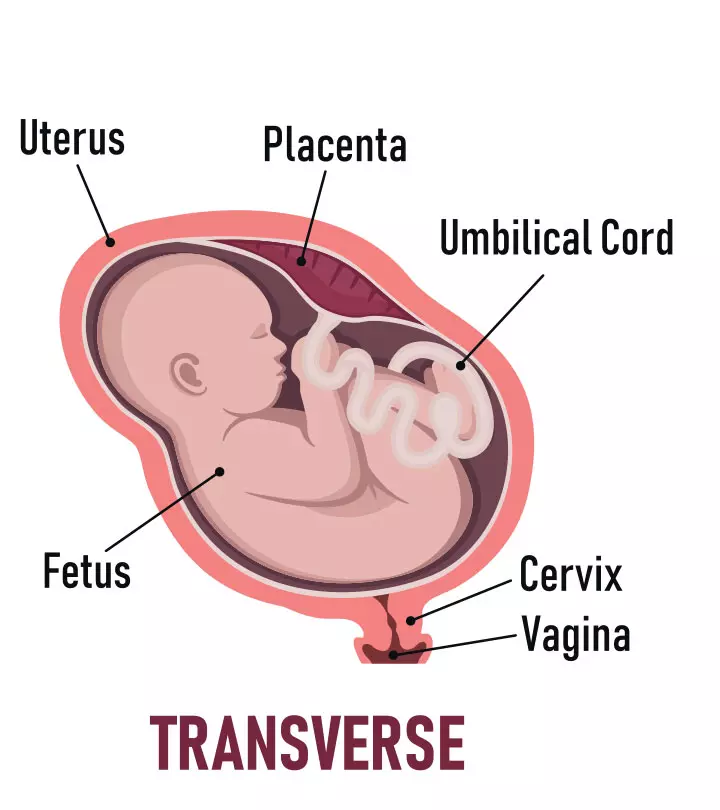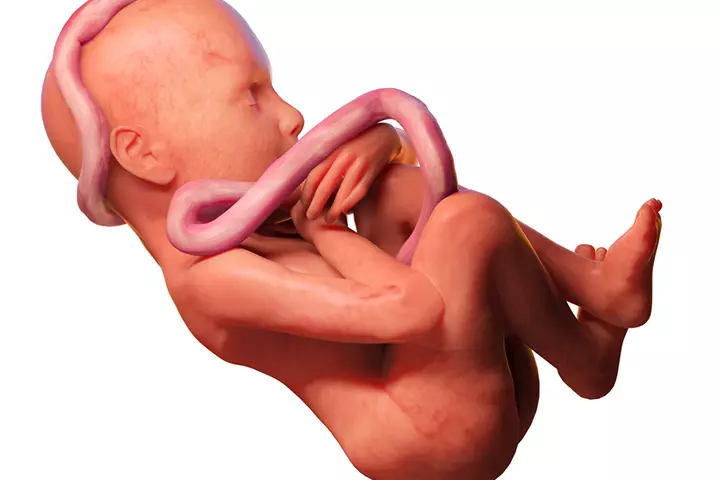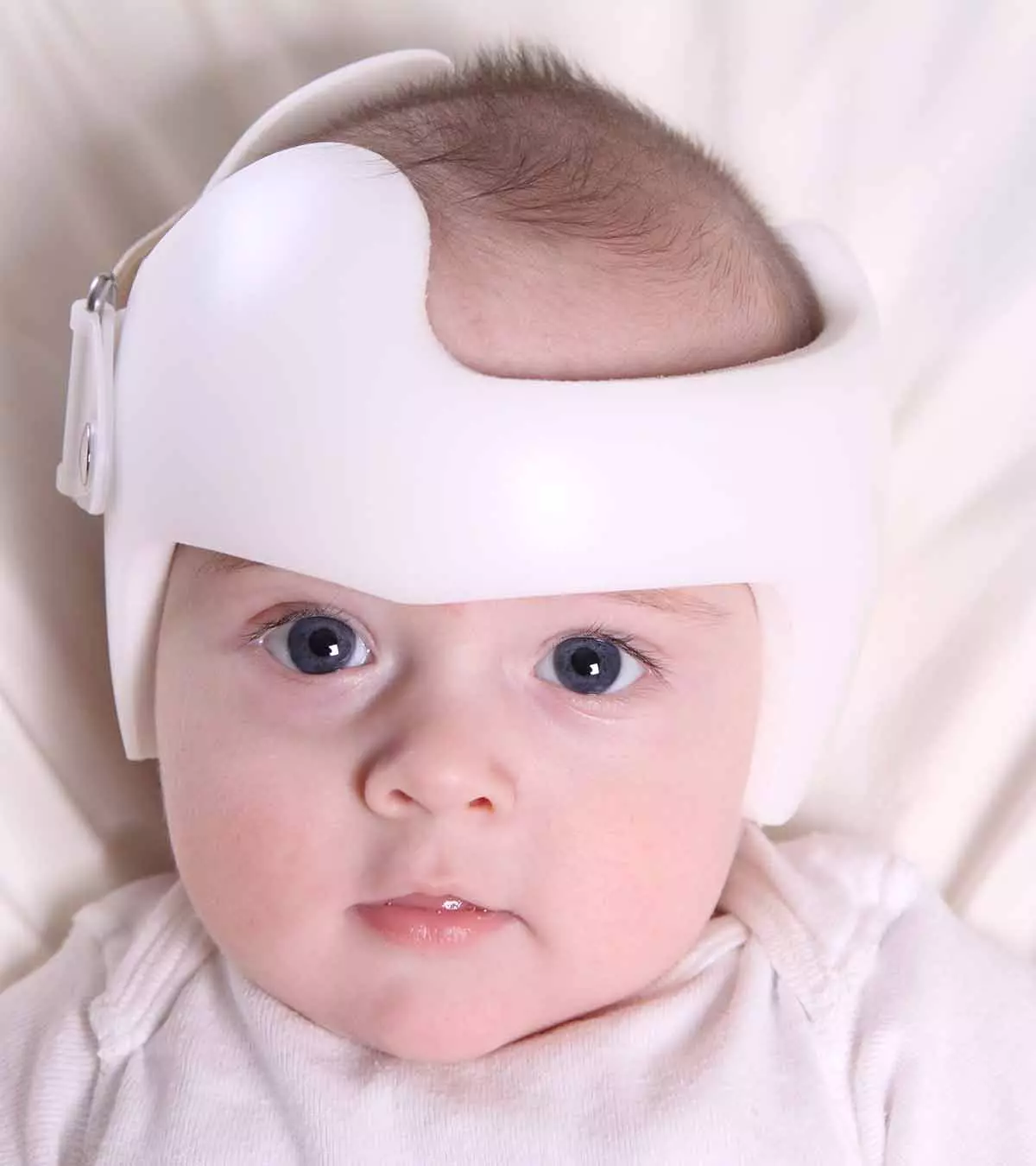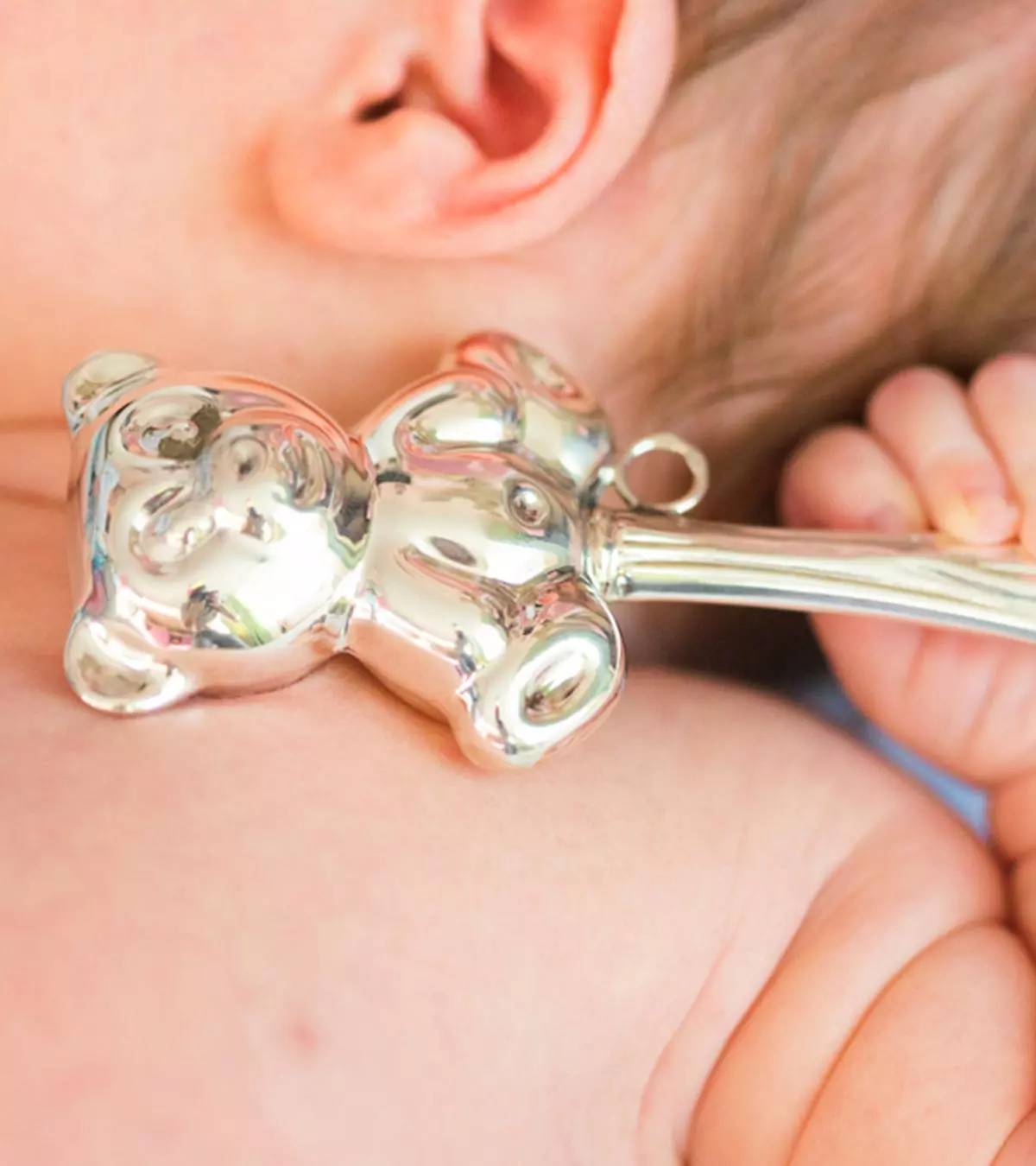
Image: ShutterStock
A transverse lie position is when your baby lies horizontally in your uterus (1). This means the baby’s head can be on one side of the mother’s body and the feet on the other side instead of the head in an up or down position. As the pregnancy advances, the baby grows and moves in the womb. Towards the end of pregnancy, most babies move to a head-down position, and this is helpful in normal vaginal delivery. Less commonly, some babies may not take up common positions and require cesarean sections to deliver them.

Read about the causes, types, risks, and other factors related to the transverse lie position.
Key Pointers
- When a baby lies in the horizontal position in the uterus, it is called the transverse lie.
- Most babies shift to the head-down position by the end of the second trimester.
- Vaginal delivery of a baby in a transverse lie is not possible. Cesarean section is the safest option to deliver the baby.
What Is A Transverse Baby Or Transverse Lie?
When the baby lies horizontally in the uterus, instead of an ideal vertical or head-down position, it is called a transverse or longitudinal lie. In simple terms, it can be said that the baby is lying sideways, which is a form of malpresentation, with its head either on the left or right side of the uterus. It is rare and could occur in one among 300 pregnancy cases (2).
The position is normal during the initial stages of pregnancy or till 26 weeks. However, it could be considered abnormal when the due date is nearing. With the baby in such a position, it is not possible to go for a normal delivery (3).
Singapore-based obstetrician and gynecologist Dr. Tan Poh Kok explains, “A transverse lie is known to pose risks to both the mother and baby. Usually, vaginal delivery is not possible in this position because the baby’s shoulders would be the presenting part. Therefore, a transverse lie is typically considered an indication for a C-section.”
The baby may come to the sideways position due to different reasons.
What Are The Causes Of Transverse Baby Position?
Usually, a transverse baby at 32 weeks and 36 weeks of pregnancy, settles down in one position during this time. In some cases, babies could naturally come to the transverse lie position. In other cases, the reasons could be (4):
- Excess amniotic fluid: Polyhydramnios or too much of amniotic fluid in the womb could increase the chances of fetal malposition. The average level of amniotic fluid is 800ml in the 34th week. However, it should be around 600ml when the baby is developed. Otherwise, the baby could move sideways and get into a transverse lie position (5).
- Twin pregnancy: In certain situations, it is possible that the second twin comes to a transverse lie position once the first twin is delivered (6).
- Multiple pregnancies: Grand multipara is the term given when a woman has given birth to more than two times. This is also one of the causes of a baby’s transverse lie position (7). However, these kinds of cases have dropped in recent times.
- Placenta previa: It is the condition when the placenta blocks the uterus, and so the baby comes to a transverse position (8).
- Fetopelvic disproportion: It is the condition when the fetal head is unable to pass through the mother’s pelvis. And so the fetal position can change from normal to transverse (7).
The doctor or midwife would assess your baby’s position with proper diagnosis.
How Is The Diagnosis Done?

Early diagnosis through abdominal and vaginal examination could determine the position of the baby. The abdominal examination can suspect fetal transverse lie when (9):
- Fundal heightiThe measurement from your pubic bone to the top of your uterus, which helps doctors track your baby's growth during pregnancy is less than what it should be according to the gestational age.
- The fetal head is in the iliac fossa (part of the hip bone) at some higher level.
- The heart rate of the fetus is heard below the umbilicusiThe medical term for your belly button .
Vaginal examination in the early and late stages of pregnancy, through the cervix, could also confirm the fetal transverse position. The ultrasound also confirms the same. During your third-trimester check-ups, your healthcare provider will examine your belly to determine the baby’s position. If the fetus is still in a breech position, they’ll continue monitoring closely. An official diagnosis of breech is typically made around 37 weeks of pregnancy (10).
 Quick fact
Quick factThe exact transverse lie position of the fetus can be determined through shoulder presentations.
What Are The Transverse Lie Positions?
There are four shoulder presentations of transverse lie (11):
- Dorsoanterior: The position of the fetus is towards the front
- Dorsoposterior: The position of the fetus is towards the back
- Dorsosuperior: This is the position where the fetal back is up
- Dorsoinferior: This is the position where the fetal back is down
As the transverse baby bump position is not considered normal, there could be certain risks when delivering the baby.
What Are The Risks For The Baby In Transverse Lie?
The transverse lie is not among the ideal baby birth positions for a natural or vaginal delivery. Hence, in every case of a transverse baby, when to schedule a C-section would be a major question to answer. Along with that, there could be other risks too.
- Diminished oxygen supply: The position decreases the flow of oxygen to the baby, which requires assisted delivery or immediate delivery through C-section to ensure the baby’s survival (12).
- Uterine ruptureiA pregnancy complication where the uterus (womb) tears or splits open, requiring immediate emergency surgery : The baby’s side position is an abnormal presentation, and there could be chances of the uterus being ruptured (13).
- Prolapsed umbilical cord: The baby’s transverse position could cause the umbilical cord to drop into the birth canal. This could be risky for the baby, because of which doctors go with the c-section delivery to bring out the baby safely (14).
- Infections: Cesarean delivery, rupture of membranes, and such complications due to transverse position could be responsible for infections (15).
- Umbilical cord compression: The transverse position of the fetus can cause stretching and twisting of the umbilical cord, leading to cord compression, which could be a serious complication for the baby as it could reduce the oxygen and blood flow to the fetus (16).

Other risks may include uncoordinated and extremely painful contractions, slow or stalled labor progress, and short-lived, irregular uterine contractions. There is also an increased risk of postpartum hemorrhageiHeavy bleeding that occurs after giving birth, which requires urgent medical attention , along with potential distress for both the mother and baby (13). To keep away the risks associated with the transverse lie position of the fetus, doctors could try to turn the baby to a different and safe position.
How To Turn A Baby From Transverse Lie?

Mothers should talk to their healthcare provider to find the best option for their situation. A qualified practitioner can offer personalized advice and help improve the chances of a successful outcome. If the transverse position has been detected in the early stages or before the baby has settled down, there are some ways through which the baby can be turned.
- Chiropractic care: One of the chiropractic techniques, termed as the Webster technique, could help turn the baby from the transverse lie position to the vertex or head down position. There is no pressure exerted on the baby during the procedure, which is considered to be effective and safe (17).
- Massage: Some abdominal massage techniques can reposition your baby from sideways to a normal head-down position. This will help the baby to come into alignment for delivery and prevent any maternal or fetal distress. However, it is important to have the massage performed by trained medical professionals, as improper techniques by unqualified individuals may lead to adverse effects (18).
- Pulsatilla: It is a homeopathy therapy that is known to help change the position of the transverse and breech babies (19). However, only a professional knows the right technique to perform this massage.
- External cephalic version (ECV): The method is used by the doctors to shift the position of the baby from transverse to head down. This technique is performed during or around 37 weeks or much before the labor starts (20). A study by the University of Southern California School of Medicine found that external cephalic version (ECV) can significantly improve the chances of a vaginal delivery. The report states “ Overall, the use of external version in the laboring patient with a transverse lie presentation was associated with a 50% reduction in the cesarean section rate (21).” If you’ve had a previous cesarean delivery, an external version could still be a good option. This technique is often successful and worth considering in such cases (22).
Janna Faye, a mother of three who faced breech position during all her pregnancies, shared her experience of undergoing an external cephalic version (ECV). She explained, “You just have to breathe through it and you want to tighten your core muscles. If you want an idea of what it feels like, imagine a ten-pound bowling ball being rolled around on your stomach, and that’s about what it feels like (i).”
 Quick fact
Quick fact- Forward leaning inversion: This exercise can be performed after 20 weeks of pregnancy and is to used shift the position of the baby (23). However, it can be performed only in a healthy pregnancy and with the doctor’s approval.
Some common questions regarding transverse lie are answered in the next section.
Frequently Asked Questions
1. What happens if the baby cannot be turned?
If the professionals and doctors are not able to turn the transverse position of the baby to a head down position, they will go with a cesarean, which can safely bring out the baby into the world.
2. What happens if I am having twins?
In case the first twin is lying in a transverse position, doctors usually perform a c-section. However, if the first twin is delivered normally, then the second twin might come to a transverse position. In this case, doctors try to turn the second baby through an internal cephalic version (manual intrauterine procedure to change transverse lie to breech) or external cephalic version and then decide whether or not it is an obstetrics emergency and if they have to schedule a c-section (7).
3. How long can a baby stay in the transverse lie position?
Most of the babies settle down in a normal position or the head-down position by the end of the second trimester or beginning of the third trimester. It is usually between 28 to 30 weeks. However, some babies also move around after the beginning of the third trimester, and tend to take the normal position by the 31st or 34th week. If they do not come to a normal position and stay transverse up to the last stage, too, may cause labor complications..
4. What is the recovery process after delivery in transverse lie?
In the case of a transverse lie during delivery, a c-section is usually necessary. This involves making an incision from side to side or vertically to remove the baby, which may require staples or stitches to close. The healing process takes four to six weeks, during which medical professionals recommend avoiding bending, lifting heavy objects, and physical strain. Additionally, baby-safe pain medications may be prescribed to facilitate a smooth recovery process (24).
The transverse lie position is uncommon and observed in a few babies nearing the delivery date. It might be caused by several reasons, such as excess amniotic fluid and multiple pregnancies. There are several types of transverse lie positions, and it is unsafe to proceed with standard vaginal delivery in such a situation. However, the baby can be delivered safely with the help of a cesarean section. Therefore, it is advised that you consult your doctor and take their opinion on which mode of delivery is safe for the mother and baby.
Infographic: Synopsis Of The Transverse Lie Position
What causes a baby to lie in a transverse position in the mother’s womb? Can it harm the baby? How do you turn a baby into a normal position? This infographic gives an easy reference to these questions. Illustration: Momjunction Design Team
Personal Experience: Source
MomJunction articles include first-hand experiences to provide you with better insights through real-life narratives. Here are the sources of personal accounts referenced in this article.
i. Breech Baby Turning Vlog – Third Trimester Pregnancy.https://www.youtube.com/watch?feature=shared&v=N_fNrjJtzFY
References
- Your Guide to Fetal Positions before Childbirth.
https://www.lancastergeneralhealth.org/health-hub-home/motherhood/your-pregnancy/your-guide-to-fetal-positions-before-childbirth - Orkun Cetin et.al; (2015); A Fatal and Extremely Rare Obstetric Complication: Neglected Shoulder Presentation at Term Pregnancy.
https://onlinelibrary.wiley.com/doi/10.1155/2015/819874#B7 - Carl E. Johnson; (1964); Transverse Presentation of Fetus.
https://jamanetwork.com/journals/jama/article-abstract/1162127 - If Your Baby Is Breech.
https://www.acog.org/womens-health/faqs/if-your-baby-is-breech - Polyhydramnios: Too Much Amniotic Fluid.
https://www.birthinjuryhelpcenter.org/birth-injuries/prenatal-problems/amniotic-fluid-excess/ - 4 Questions to Ask if Your Doctor Suggests a Scheduled C-Section.
https://healthtalk.unchealthcare.org/4-questions-to-ask-if-your-doctor-suggests-a-scheduled-c-section/ - Transverse lie and shoulder presentation.
https://medicalguidelines.msf.org/en/viewport/ONC/english/7-6-transverse-lie-and-shoulder-presentation-51417541.html - O. Oyinloye and Alexander A. Okoyomo; (2010); Longitudinal evaluation of foetal transverse lie using ultrasonography.
https://www.semanticscholar.org/paper/Longitudinal-evaluation-of-foetal-transverse-lie-Oyinloye-Okoyomo/46d89e78a77b2e0f9ea766ff095948c72da604d7?p2df - Robina Ali and Aisha Abrar; (2011); Transverse Lie; Predisposing Factors Maternal And Perinatal Outcome.
https://applications.emro.who.int/imemrf/Professional_Med_J_Q/Professional_Med_J_Q_2011_18_2_208_211.pdf - Breech Baby.
https://my.clevelandclinic.org/health/diseases/21848-breech-baby - Samjhana Dhakal; (2010); Spontaneous Vaginal Delivery of an Average Sized Dead Baby with Hand Prolapse at Term: A Case Report.
https://www.nepjol.info/index.php/NJOG/article/view/5065 - Malpresentation.
https://www.pregnancybirthbaby.org.au/malpresentation - Labour and Delivery Care Module: 8. Abnormal Presentations and Multiple Pregnancies.
https://www.open.edu/openlearncreate/mod/oucontent/view.php?id=276&printable=1 - Umbilical Cord Prolapse.
https://www.ncbi.nlm.nih.gov/books/NBK542241/ - Mary Ellen Gee et.al; (2025); Caesarean section: techniques and complications.
https://www.sciencedirect.com/science/article/abs/pii/S1751721420300178 - Umbilical cord prolapse in late pregnancy.
https://www.rcog.org.uk/media/piolvnsu/pi-umbilical-cord-prolapse-in-late-pregnancy.pdf - Tamara Smith B. A; (2004); Webster Technique and In Utero Constraint: An Explanation.
https://www.logan.edu/mm/files/LRC/Senior-Research/2005-Apr-50.pdf - Maria Sriana Banul and Silfia Angela N. Halu; (2025); Analysis of Abdominal Massage Practice Performed by Traditional Birth Attendants in Mamba Community Health Center East Nusa Tenggara.
https://www.cabidigitallibrary.org/doi/pdf/10.5555/20210129345 - Homeopathy for Breech.
https://betterbirthblog.org/breech/turn-a-breech/homeopathy-for-breech/ - External Cephalic Version for Breech Position.
https://www.uofmhealth.org/health-library/hw180146 - Jeffrey P. Phelan et.al; (1985); The role of external version in the intrapartum management of the transverse lie presentation.
https://www.sciencedirect.com/science/article/abs/pii/0002937885905046 - Breech Births.
https://americanpregnancy.org/healthy-pregnancy/labor-and-birth/breech-presentation/ - How to Perform a Forward Leaning Inversion.
https://www.brookingshealth.org/videos/how-perform-forward-leaning-inversion - C-Section.
https://my.clevelandclinic.org/health/treatments/7246-cesarean-birth-c-section - Transverse Lie.
https://obgyn.mhmedical.com/content.aspx?bookid=1247§ionid=75163791
Community Experiences
Join the conversation and become a part of our nurturing community! Share your stories, experiences, and insights to connect with fellow parents.
Read full bio of Dr. Neha Singh

Dr. Tan Poh Kok (PK Tan) is a senior consultant obstetrician and gynecologist at PK Women’s Specialist Centre in Singapore. He got trained at the National University of Singapore and the Royal College of Obstetricians and Gynaecology in the UK. Dr. Tan specializes in women’s health issues, including endometriosis, ovarian cysts, cervical cancer, fertility problems, and uro-gynecology.
Dr. Tan Poh Kok (PK Tan) is a senior consultant obstetrician and gynecologist at PK Women’s Specialist Centre in Singapore. He got trained at the National University of Singapore and the Royal College of Obstetricians and Gynaecology in the UK. Dr. Tan specializes in women’s health issues, including endometriosis, ovarian cysts, cervical cancer, fertility problems, and uro-gynecology.
Read full bio of Rebecca Malachi
Read full bio of Dr. Ritika Shah
Read full bio of Reshmi Das
















